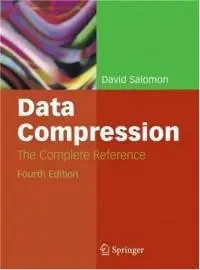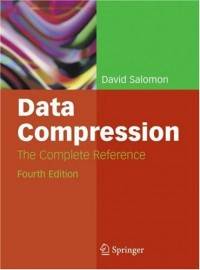Data Compression: The Complete Reference - 4th Ed.
Springer | ISBN: 1846286026 | 2006. | 1111 p. | RARed PDF 7.38MB
Data compression is one of the most important techniques in computing engineering. From archiving data to CD-ROMs and from coding theory to image analysis, many facets of computing make use of data compression in one form or another. This book is intended to provide an overview of the many different types of compression: it includes a taxonomy, an analysis of the most common systems of compression, discussion of their relative benefits and disadvantages, and their most common usages. Readers are presupposed to have a basic understanding of computer science: essentially the storage of data in bytes and bits and computing terminology, but otherwise this book is self-contained. The book divides naturally into four main parts based on the main branches of data compression: run length encoding, statistical methods, dictionary-based methods, and lossy image compression (where in contrast to the other techniques, information in the data may be lossed but an acceptable standard of image quality retained). Detailed descriptions of many of the most well-known compression techniques are covered including: Zip, BinHex, Huffman coding, GIF and many others.
Giambattista della Porta, a Renaissance scientist sometimes known as the professor of secrets, was the author in 1558 of Magia Naturalis (Natural Magic), a book in which he discusses many subjects, including demonology, magnetism, and the camera obscura [della Porta 58]. The book became tremendously popular in the 16th century and went into more than 50 editions, in several languages beside Latin. The book mentions an imaginary device that has since become known as the “sympathetic telegraph.” This device was to have consisted of two circular boxes, similar to compasses, each with a magnetic needle. Each box was to be labeled with the 26 letters, instead of the usual directions, and the main point was that the two needles were supposed to be magnetized by the same lodestone. Porta assumed that this would somehow coordinate the needles such that when a letter was dialed in one box, the needle in the other box would swing to point to the same letter.
Needless to say, such a device does not work (this, after all, was about 300 years before Samuel Morse), but in 1711 a worried wife wrote to the Spectator, a London periodical, asking for advice on how to bear the long absences of her beloved husband. The adviser, Joseph Addison, offered some practical ideas, then mentioned Porta’s device, adding that a pair of such boxes might enable her and her husband to communicate with each other even when they “were guarded by spies and watches, or separated by castles and adventures.” Mr. Addison then added that, in addition to the 26 letters, the sympathetic telegraph dials should contain, when used by lovers, “several entire words which always have a place in passionate epistles.” The message “I love you,” for example, would, in such a case, require sending just three symbols instead of ten.
NO mirrors, please !
Pass: www.AvaxHome.ru
===========================
<a href="http://cutt.red/iemieJiw6eeJ?search=Data%20Compression%3A%20The%20Complete%20Reference%20-%204th%20Ed." rel="nofollow noopener" onclick="log_click('Data%20Compression%3A%20The%20Complete%20Reference%20-%204th%20Ed.', 'cutt.red'); return true;" target="_blank" rel="nofollow noopener noreferrer">Download</a>
===========================
===== ===== =====
=== === ===
= = =
-> My other posts <-
= = =



